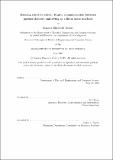Dancing cheek to cheek : haptic communication between partner dancers and swing as a finite state machine
Author(s)
Gentry, Sommer Elizabeth
DownloadFull printable version (1.224Mb)
Alternative title
Haptic communication between partner dancers and swing as a finite state machine
Other Contributors
Massachusetts Institute of Technology. Dept. of Electrical Engineering and Computer Science.
Advisor
Eric Feron.
Terms of use
Metadata
Show full item recordAbstract
To see two expert partners, one leading and the other following, swing dance together is to watch a remarkable two-agent communication and control system in action. Even blindfolded, the follower can decode the leader's moves from haptic cues. The leader composes the dance from the vocabulary of known moves so as to complement the music he is dancing to. Systematically addressing questions about partner dance communication is of scientific interest and could improve human-robotic interaction, and imitating the leader's choreographic skill is an engineering problem with applications beyond the dance domain. Swing dance choreography is a finite state machine, with moves that transition between a small number of poses. Two automated choreographers are presented. One uses an optimization and randomization scheme to compose dances by a sequence of shortest path problems, with edge lengths measuring the dissimilarity of dance moves to each bar of music. The other solves a two-player zero-sum game between the choreographer and a judge. Choosing moves at random from among moves that are good enough is rational under the game model. (cont.) Further, experiments presenting conflicting musical environments to two partners demonstrate that although musical expression clearly guides the leader's choice of moves, the follower need not hear the same music to properly decode the leader's signals. Dancers embody gentle interaction, in which each participant extends the capabilities of the other, and their cooperation is facilitated by a shared understanding of the motions to be performed. To demonstrate that followers use their understanding of the move vocabulary to interact better with their leaders, an experiment paired a haptic robot leader with human followers in a haptically cued dance to a swing music soundtrack. The subjects' performance differed significantly between instances when the subjects could determine which move was being led and instances when the subjects could not determine what the next move would be. Also, two-person teams that cooperated haptically to perform cyclical aiming tasks showed improvements in the Fitts' law or Schmidt's law speed-accuracy tradeoff consistent with a novel endpoint compromise hypothesis about haptic collaboration.
Description
Thesis (Ph. D.)--Massachusetts Institute of Technology, Dept. of Electrical Engineering and Computer Science, 2005. This electronic version was submitted by the student author. The certified thesis is available in the Institute Archives and Special Collections. Vita. Includes bibliographical references (p. 129-138).
Date issued
2005Department
Massachusetts Institute of Technology. Department of Electrical Engineering and Computer SciencePublisher
Massachusetts Institute of Technology
Keywords
Electrical Engineering and Computer Science.